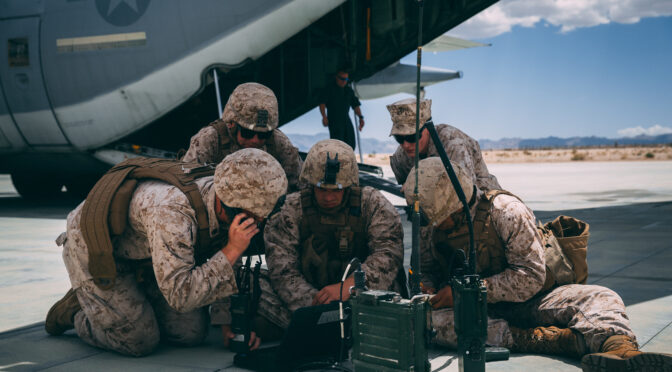Transforming the Marine Corps Topic Week
Capt. Jesse Schmitt, U.S. Marine Corps
One of the U.S. Marine Corps’ greatest strengths has been a weakness of late. Its storied history and rich service culture make it an organization notoriously resistant to critical self-examination and change. If “man cannot remake himself without suffering, for he is both the marble and the sculptor,” then the Marine Corps is particularly fond of its own marble and sensitive to the chisel.1 Such a fondness explains the spate of articles from retired Marine Corps leaders criticizing the “hasty” execution of 2019 Commandant’s Planning Guidance (CPG) and lamenting they sacrifice critical aspects of the Marine Corps combined arms heritage.
Taken sincerely, it represents well-intentioned men and women expressing concern for a service they care about. However, they should not be heeded if the Marine Corps is to realize its status as a modern and relevant force provider. Change is at the heart of maneuver warfare philosophy. This framework should guide the Marine Corps’ plans strategically as it does tactically, given the trajectory of global affairs. Applied, this process will see the Marine Corps carve its own marble to provide relevant and novel capabilities to combatant commanders, while shedding legacy capabilities that are ill-suited for the realities of the modern battlefield.
Well Meaning, But Wrong
It is useful to understand the critiques leveled at the Commandant’s Planning Guidance. Some of the critiques can be specifically refuted, such as General Zinni’s (USMC (ret.)), assertion that the proposed changes “do not meet … requirements and do not meet the needs of the combatant commander.”2 Meanwhile, General Todd Wolters, current Commander of U.S. European Command, told the House Armed Services Committee that the changes “dramatically enhance(s) our options … a brown-water force that can shoot, move and communicate and is very expeditionary is priceless for 21st century security.”3 Lieutenant General Van Riper’s chief complaint concerns the speed of change and overall lack of due diligence. This commentary fails to account for years of wargaming and study dating back to Commandant Neller’s tenure and for several years’ worth of oversight from the Office of the Secretary of Defense (OSD), the Joint Staff, and Congress.4
Notably, nearly all of the capabilities slated for divestment (with the exception of tanks—shed for the incompatibility of tank units with expeditionary operations) have only been reduced in capacity to make way for novel and relevant capabilities. Despite changes to the III Marine Expeditionary Force, the domestic-based Marine Corp expeditionary forces remain largely unchanged, outside of reduced capacity in cannon artillery (to be replaced by precision long-range fires, such as rockets and missiles) and aircraft.
Change is the Answer
It must be accepted as fact that change is required. The last four Commandants all agree, dating back to 2011, that the Marine Corps must evolve beyond the force that deployed to Operation Enduring Freedom, Operation Iraqi Freedom, and Operation Inherent Resolve. Even those who oppose the CPG’s restructuring concede the point: Lt Gen. Van Riper (ret.) told Politico, “We recognize that the Marine Corps has to make changes,… what we want to see is these changes based on thorough study and analysis…”5 No serious commenter claims that the Marine Corps should not grow to take advantage of new capabilities and learn to operate in a more complex operating environment impacted by ubiquitous and emerging technologies. The disagreement, then, exists over the speed and extent of said changes.
Incremental change fails to achieve the objective of the change. The purpose of the Marine Corps’ evolution is to frustrate the adversary’s plans to mitigate Marine capabilities. Strategic competitors have observed the Department of Defense’s actions over the last two decades of operations and structured themselves accordingly.6 What they have not planned to directly counter and destroy, they have done their best to copy. A current Marine infantry battalion, equipped and enabled with legacy systems, represents a dangerous and noteworthy quantity, but a known one.
For example, the classical model of Marine Expeditionary Units (MEU)—consisting of three ships, with a composite squadron on the big deck, and a Battalion Landing Team organized as company raid forces — have routinely deployed for decades, establishing patterns of employment and capability. These are not incapable systems and their roles as flexible deterrents below the threshold of conflict are useful, but they have existed long enough in their current forms that adversaries have developed counters to reduce their deterrent value.
Taken further, Anti-Ship Cruise Missile (ASCM) proliferation limits the MEU’s Amphibious Ready Group (ARG) littoral access (and relevance) in conflict.7 However, adding piecemeal capabilities, such as unmanned systems to an infantry battalion or Information-Related Capabilities (IRCs) to a MEU does not move the needle. An organization committed to maneuver warfare should recognize these adaptations by competitors and modify itself to maintain an advantage.
The Marine Corps’ Greatest Strength
Fortunately, the Marine Corps’ greatest asset has always been its people, particularly those that lead Marines in chaotic and unknowable environments. From the outset, Marine leaders are trained to act in the “intrinsically unpredictable” nature of war, because that is what enables success in combat.8 Do not take the Marine Corps’ word for it, either. In 2015, the People’s Republic of China (PRC) Central Military Commission, chaired by President Xi Jinping released a document that came to be known as the “Five Incapables.” The document detailed shortcomings of the People’s Liberation Army (PLA) force, particularly the inability of enlisted and junior officers to judge situations, understand higher authorities’ intentions, make operational decisions, deploy troops, and deal with unexpected situations. This document has been referenced hundreds of times in the PLA Daily—the official newspaper of the PLA— between 2015 and 2019.9
The contrast is clear: where strategic competitors struggle to cope with ambiguous situations the Marine Corps thrives in them. The reasons for this trait in autocratic systems are manifold, from a reliance on higher-ranking decision makers to political oversight of commanding officers.10,11 The best way for the Marine Corps to be a relevant, capable resource to Combatant Commanders is to be a force that can create those ambiguous, chaotic situations and then use its advantage in them to win. That principle holds true regardless of the adversary from the Indo-Pacific to the polar regions and points in between.
A smaller, less expensive, but uncertain and survivable entity can be more disruptive to the enemy’s understanding of the situation than any current systems, making it a more effective use of resources. Developing new capabilities to modernize the Marine Corps’ ability to defeat an enemy’s plan is precisely what maneuver warfare doctrine calls for to “circumvent a problem and attack it from a position of advantage.”12 With ubiquitous advances in long range fire — not just in the Indo-Pacific — highly nimble, survivable, and independent forces capable of operating inside a given weapons engagement zone will critical to a future fight.
Finally, what all critiques have failed to appreciate is that the most important change is not equipment or manpower, it is the creation and invigoration of a culture that seeks novel solutions to novel problems. By publishing the CPG, making important divestments, and following through, the Commandant of the Marine Corps has empowered an entire generation of Marines to think boldly about what comes next. The opportunity cost of maintaining antiquated structures and systems is not just fiscal, but one of growth. Necessity, embodied by a new environment, drives innovation and creates novel problems for competitors. The CPG has explicitly called out the new environment and situation; it is now the institution’s responsibility to adapt.
The Commandant’s Planning Guidance appropriately and meaningfully empowers institutional change in recognition of a shifting environment and the capabilities of strategic competitors. The inherent challenges of the modern battlefield cannot be met by legacy structures and systems. The process—akin to maneuver warfare at the strategic level—will not be painless, as the Marine Corps carves from its own marble to provide relevant and novel capabilities to combatant commanders in any clime or place.
Captain Jesse Schmitt is the S-2a for the 31st Marine Expeditionary Unit in Okinawa, Japan. He has a Master’s degree in International Relations and has written for CIMSEC, War on the Rocks, U.S. Naval Institute Proceedings, and the Marine Corps Gazette.
References
- Alexis Carrel, “Man, the Unknown”, 1935
- https://taskandpurpose.com/opinion/zinni-marine-corps-role/
- https://www.politico.com/news/2022/04/01/corps-detat-how-two-dozen-retired-generals-are-trying-to-stop-an-overhaul-of-the-marines-00022446
- https://warontherocks.com/2020/02/to-deter-china-the-naval-services-must-integrate/
- https://www.politico.com/news/2022/04/01/corps-detat-how-two-dozen-retired-generals-are-trying-to-stop-an-overhaul-of-the-marines-00022446
- http://www.nids.mod.go.jp/publication/chinareport/pdf/china_report_EN_web_2022_A01.pdf
- https://www.andrewerickson.com/2014/05/a-low-visibility-force-multiplier-assessing-chinas-cruise-missile-ambitions/
- MCDP-1, Warfighting
- https://warontherocks.com/2019/02/the-chinese-military-speaks-to-itself-revealing-doubts/
- https://www.japantimes.co.jp/news/2021/11/27/national/japan-china-military-report-integration/
- https://news.usni.org/2020/07/03/political-commissars-on-chinese-warships-play-crucial-role-in-interactions-with-foreign-vessels
- MCDP-1, Warfighting
Featured Image: Marines with 5th Battalion, 11th Marine Regiment, 1st Marine Division, arrive at one of their launch positions with the High-Mobility Artillery Rocket System at the Air Combat Element landing strip as a part of Integrated Training Exercise 3-18 aboard the Marine Corps Air Ground Combat Center, Twentynine Palms, Calif., May 21, 2018. (U.S. Marine Corps photo by Lance Corporal William Chockey)


